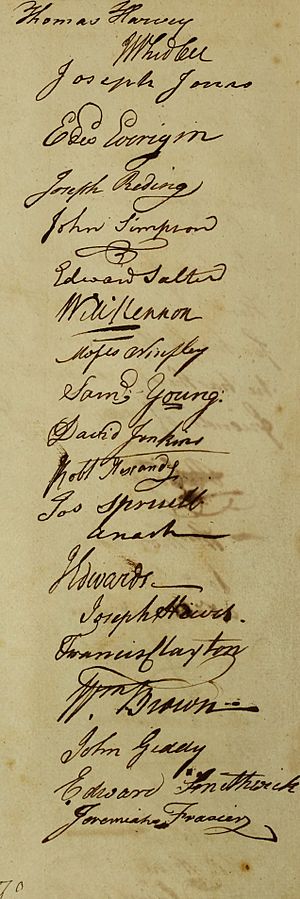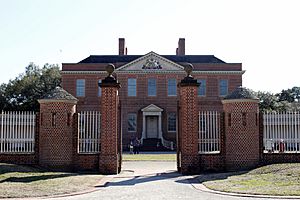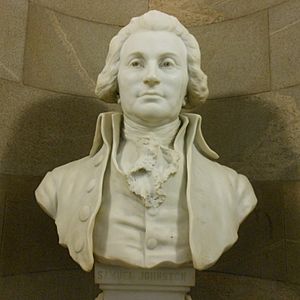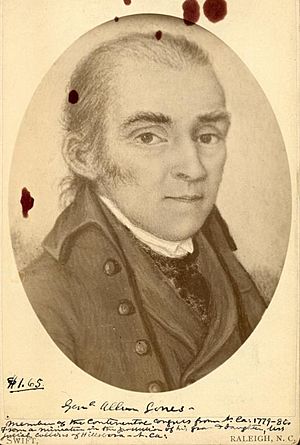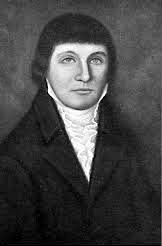North Carolina Provincial Congress facts for kids
Imagine a time when North Carolina was ruled by Great Britain. But some brave people wanted to make their own rules! The North Carolina Provincial Congresses were special meetings held by the people of North Carolina between 1774 and 1776. They were like a new government, created by the people, separate from the British rulers.
There were five of these important meetings. They took place in towns like New Bern, Hillsborough, and Halifax. At the fourth meeting, they approved the Halifax Resolves. This was a big step! It allowed North Carolina's representatives to agree to the Declaration of Independence from Great Britain. The fifth meeting created North Carolina's first Constitution. They also chose Richard Caswell as the first governor of the new State of North Carolina. After these congresses, the official North Carolina General Assembly started meeting in April 1777.
Contents
North Carolina's First Government
From 1774 to 1776, five special groups called the North Carolina Provincial Congresses met. They were set up like the old colonial government's lower house. These congresses did many important things. They created a new government for North Carolina. They also printed money to help pay for their efforts. They even organized an army to protect the people.
These groups wrote a constitution and a list of rights. This officially created the State of North Carolina. In their last meeting, they elected the state's first acting governor. These congresses helped prepare the way for the first official meeting of the North Carolina state Legislature. This happened on April 7, 1777, in New Bern, North Carolina.
First Provincial Congress: A Brave Start
The very first congress met in New Bern. It was held at the Tryon Palace from August 25 to 27, 1774. This was a really big deal! It was the first time any of the Thirteen Colonies held such a meeting against British orders.
John Harvey was the leader, or "moderator," of this meeting. He was also the last speaker of the old British colonial assembly.
Sixty-nine representatives from 30 counties attended this first congress. They decided to call a larger meeting for all the colonies, which became the Continental Congress. They chose William Hooper, Joseph Hewes, and Richard Caswell to represent North Carolina there. The congress also agreed to stop trading with Britain. This was a way to protest what Britain was doing to New England.
Second Provincial Congress: Saying Goodbye to British Rule
The second congress also met in New Bern. It was held from April 3 to 7, 1775. John Harvey was again the leader. This meeting happened at the same time and place as the British colonial assembly. Many of the same people were in both groups.
This made the royal governor, Josiah Martin, very angry. He officially ended the colonial legislature on April 8. He never called another one. This congress agreed to an economic boycott, which was approved by the Continental Congress. Soon after this meeting, news arrived about the Battle of Lexington and Concord in Massachusetts.
After hearing this news, Governor Josiah Martin fled. This marked the end of British rule in North Carolina. The first military action by the patriots happened on July 18. They burned Fort Johnston, where Governor Martin had moved his headquarters.
Third Provincial Congress: Taking Control
The third congress met in Hillsborough. It was held from August 20 to September 10, 1775. Samuel Johnston became the new president, as John Harvey had recently passed away. Every county and town sent representatives to this congress.
This meeting officially declared itself the highest government in North Carolina. British Governor Martin had already fled, so royal rule was over.
To govern North Carolina when the congress was not meeting, they elected a 13-member Provincial Council. This was the first executive body in North Carolina that was free from British control. Cornelius Harnett was chosen as the first president of this council. The congress also divided the state into six military areas. This helped organize the local armies, called militias, and decided how many representatives each area would have on the Council. These areas included Edenton, Halifax, Hillsborough, New Bern, Salisbury, and Wilmington. Later, another area called Morgan was added for the western part of the state.
Fourth Provincial Congress: Declaring Independence
Today, the fourth North Carolina Provincial Congress is sometimes called the "Halifax Assembly." This congress was also led by Samuel Johnston. It met in Halifax from April 4 to May 14, 1776. Allen Jones served as the vice-president.
This congress passed a very important document known as the Halifax Resolves. This was the first "official" statement from one of the Thirteen Colonies supporting independence from Great Britain. Joseph Hewes presented the Halifax Resolves to the Continental Congress on May 27. On the same day, representatives from Virginia also presented similar ideas.
Fifth Provincial Congress: A New State is Born
The fifth and final Provincial Congress met in Halifax. It was held from November 12 to December 23, 1776. Richard Caswell was the president, and Cornelius Harnett was the vice-president.
This congress approved the first Constitution of North Carolina. They also approved a "Declaration of Rights." These documents set up the rules for the new state. The congress elected Caswell to be the acting governor. He would serve until North Carolina's first General Assembly could meet and elect a governor.


